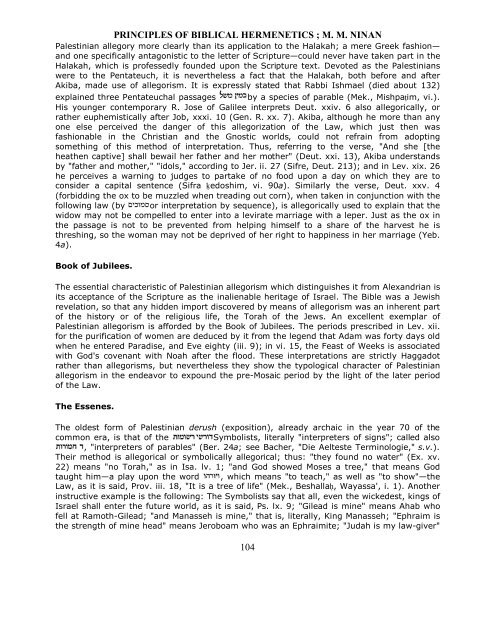Biblical Hermeneutics
Create successful ePaper yourself
Turn your PDF publications into a flip-book with our unique Google optimized e-Paper software.
PRINCIPLES OF BIBLICAL HERMENETICS ; M. M. NINAN<br />
Palestinian allegory more clearly than its application to the Halakah; a mere Greek fashion—<br />
and one specifically antagonistic to the letter of Scripture—could never have taken part in the<br />
Halakah, which is professedly founded upon the Scripture text. Devoted as the Palestinians<br />
were to the Pentateuch, it is nevertheless a fact that the Halakah, both before and after<br />
Akiba, made use of allegorism. It is expressly stated that Rabbi Ishmael (died about 132)<br />
explained three Pentateuchal passages by a species of parable (Mek., Mishpaṭim, vi.).<br />
His younger contemporary R. Jose of Galilee interprets Deut. xxiv. 6 also allegorically, or<br />
rather euphemistically after Job, xxxi. 10 (Gen. R. xx. 7). Akiba, although he more than any<br />
one else perceived the danger of this allegorization of the Law, which just then was<br />
fashionable in the Christian and the Gnostic worlds, could not refrain from adopting<br />
something of this method of interpretation. Thus, referring to the verse, "And she [the<br />
heathen captive] shall bewail her father and her mother" (Deut. xxi. 13), Akiba understands<br />
by "father and mother," "idols," according to Jer. ii. 27 (Sifre, Deut. 213); and in Lev. xix. 26<br />
he perceives a warning to judges to partake of no food upon a day on which they are to<br />
consider a capital sentence (Sifra ḳedoshim, vi. 90a). Similarly the verse, Deut. xxv. 4<br />
(forbidding the ox to be muzzled when treading out corn), when taken in conjunction with the<br />
following law (by or interpretation by sequence), is allegorically used to explain that the<br />
widow may not be compelled to enter into a levirate marriage with a leper. Just as the ox in<br />
the passage is not to be prevented from helping himself to a share of the harvest he is<br />
threshing, so the woman may not be deprived of her right to happiness in her marriage (Yeb.<br />
4a).<br />
Book of Jubilees.<br />
The essential characteristic of Palestinian allegorism which distinguishes it from Alexandrian is<br />
its acceptance of the Scripture as the inalienable heritage of Israel. The Bible was a Jewish<br />
revelation, so that any hidden import discovered by means of allegorism was an inherent part<br />
of the history or of the religious life, the Torah of the Jews. An excellent exemplar of<br />
Palestinian allegorism is afforded by the Book of Jubilees. The periods prescribed in Lev. xii.<br />
for the purification of women are deduced by it from the legend that Adam was forty days old<br />
when he entered Paradise, and Eve eighty (iii. 9); in vi. 15, the Feast of Weeks is associated<br />
with God's covenant with Noah after the flood. These interpretations are strictly Haggadot<br />
rather than allegorisms, but nevertheless they show the typological character of Palestinian<br />
allegorism in the endeavor to expound the pre-Mosaic period by the light of the later period<br />
of the Law.<br />
The Essenes.<br />
The oldest form of Palestinian derush (exposition), already archaic in the year 70 of the<br />
common era, is that of the<br />
Symbolists, literally "interpreters of signs"; called also<br />
, "interpreters of parables" (Ber. 24a; see Bacher, "Die Aelteste Terminologie," s.v.).<br />
Their method is allegorical or symbolically allegorical; thus: "they found no water" (Ex. xv.<br />
22) means "no Torah," as in Isa. lv. 1; "and God showed Moses a tree," that means God<br />
taught him—a play upon the word , which means "to teach," as well as "to show"—the<br />
Law, as it is said, Prov. iii. 18, "It is a tree of life" (Mek., Beshallaḥ, Wayassa', i. 1). Another<br />
instructive example is the following: The Symbolists say that all, even the wickedest, kings of<br />
Israel shall enter the future world, as it is said, Ps. lx. 9; "Gilead is mine" means Ahab who<br />
fell at Ramoth-Gilead; "and Manasseh is mine," that is, literally, King Manasseh; "Ephraim is<br />
the strength of mine head" means Jeroboam who was an Ephraimite; "Judah is my law-giver"<br />
104


















